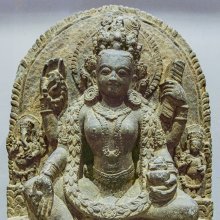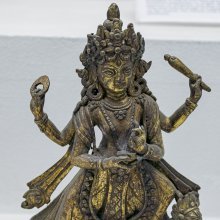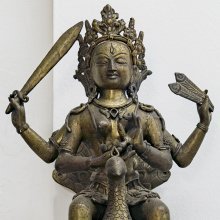Ashtamatrika, Ashtan-matrika, Aṣṭamātṛkā: 4 definitions
Introduction:
Ashtamatrika means something in Buddhism, Pali, Hinduism, Sanskrit. If you want to know the exact meaning, history, etymology or English translation of this term then check out the descriptions on this page. Add your comment or reference to a book if you want to contribute to this summary article.
The Sanskrit term Aṣṭamātṛkā can be transliterated into English as Astamatrka or Ashtamatrika, using the IAST transliteration scheme (?).
Images (photo gallery)
In Hinduism
Purana and Itihasa (epic history)
Source: archive.org: Naisadhacarita of Sriharsa (purana)Aṣṭamātṛkā (अष्टमातृका) refers to a set of Eight Mothers (Goddesses).—Devībhāgavata (12.11.57-58) mentions eight Mātṛs, namely:
- Brāhmī,
- Māheśvarī,
- Kaumārī,
- Vaiṣṇavī,
- Vārāhī,
- Indrāṇī,
- Cāmuṇḍā,
- Mahālakṣmī.
The characteristics of these eight are described in detail in the Nityāṣoḍaśikārṇava belonging to Vāmakeśvara-tantra (8.126ff). The eight Mātṛs mentioned above are enumerated also in Prapañcasāra-tantra 7.11, and invoked in the KArṇejapa hymn found in Kulacūḍāmaṇi-tantra (chapter 3). Devībhāgavata in another place (9.50) enumerats the eight Mātṛs, but here Nārasiṃhī is substituted for Mahālakṣmī. In the list of the eight Mātṛs in Devīpurāṇa (37.83-90), Rudrāṇī takes the place of Nārasiṃhī or Mahālakṣmī, the other names being the same as in Devībhāgavata. Eight Mātṛs are mentioned in Liṅgapurāṇa (Pūrvārdha 82.96), in which a new name appears, Āgneyikā in place of Mahālakṣmī or Nārasiṃhī or Rudrāṇī.
The eight Mātṛs mentioned in the Mantramahodadhi (3.17-18) of Mahīdhara (compiled from earlier sources) are:
- Brāhmī,
- Nārāyaṇī,
- Māheśvarī,
- Cāmuṇḍā,
- Kaumārī,
- Aparājitā,
- Vārāhī,
- Nārasiṃhī.
There is another list in 1.64-65, which agrees with that found in Devībhāgavata 12.11.
Varāhapurāṇa (chapter 27) describes the origin of the eight Mātṛs in the course of Śiva’s fight with the Andhaka demon, and gives the following names:
- Yogeśvarī,
- Māheśvarī,
- Vaiṣṇavī,
- Brahmāṇī,
- Kaumārī,
- Māhendrī,
- Vārāhī,
- Yāmī (Yamadaṇḍadharā).

The Purana (पुराण, purāṇas) refers to Sanskrit literature preserving ancient India’s vast cultural history, including historical legends, religious ceremonies, various arts and sciences. The eighteen mahapuranas total over 400,000 shlokas (metrical couplets) and date to at least several centuries BCE.
Shaktism (Shakta philosophy)
Source: Wisdom Library: ŚāktismAṣṭamātṛkā (अष्टमातृका) refers to the “eight mother Goddesses” of Kathmandu city, each having a local deity name:—
- Brahmāyaṇī (Pāsikvaḥ Ajimā),
- Vaiṣṇavī (Nay Ajimā),
- Māheśvarī or Rudrāyaṇī (Mhayepi Ajimā),
- Indrāyaṇī (Luti Ajimā),
- Kaumārī (Lũmadhi Ajimā),
- Vārāhī (Phibva Ajimā),
- Cāmuṇḍā (Kaṅga Ajimā or Kaṅkeśvarī),
- Mahālakṣmī (Candralakhu Ajimā).

Shakta (शाक्त, śākta) or Shaktism (śāktism) represents a tradition of Hinduism where the Goddess (Devi) is revered and worshipped. Shakta literature includes a range of scriptures, including various Agamas and Tantras, although its roots may be traced back to the Vedas.
In Buddhism
Tibetan Buddhism (Vajrayana or tantric Buddhism)
Source: OSU Press: Cakrasamvara SamadhiAṣṭamātṛkā (अष्टमातृका) refers to a group of deities, according to the Guru Mandala Worship (maṇḍalārcana) ritual often performed in combination with the Cakrasaṃvara Samādhi, which refers to the primary pūjā and sādhanā practice of Newah Mahāyāna-Vajrayāna Buddhists in Nepal.

Tibetan Buddhism includes schools such as Nyingma, Kadampa, Kagyu and Gelug. Their primary canon of literature is divided in two broad categories: The Kangyur, which consists of Buddha’s words, and the Tengyur, which includes commentaries from various sources. Esotericism and tantra techniques (vajrayāna) are collected indepently.
Languages of India and abroad
Sanskrit dictionary
Source: DDSA: The practical Sanskrit-English dictionaryAṣṭamātṛkā (अष्टमातृका).—ब्राह्मी, माहेश्वरी, कौमारी, वैष्णवी, वाराही, इन्द्राणी, कौबेरी (brāhmī, māheśvarī, kaumārī, vaiṣṇavī, vārāhī, indrāṇī, kauberī), and चामुण्डा (cāmuṇḍā).
Derivable forms: aṣṭamātṛkāḥ (अष्टमातृकाः).
Aṣṭamātṛkā is a Sanskrit compound consisting of the terms aṣṭan and mātṛkā (मातृका).
Sanskrit, also spelled संस्कृतम् (saṃskṛtam), is an ancient language of India commonly seen as the grandmother of the Indo-European language family (even English!). Closely allied with Prakrit and Pali, Sanskrit is more exhaustive in both grammar and terms and has the most extensive collection of literature in the world, greatly surpassing its sister-languages Greek and Latin.
See also (Relevant definitions)
Partial matches: Ashta, Matrika.
Full-text: Matrika, Ashtamatri, Ashtamata, Rudrayani, Brahmayani, Indrayani, Kankeshvari, Saptamatrika, Varahi, Narasimhika, Vaishnavi, Mahalakshmi, Kaumari, Narasimhini, Maheshvari, Camunda, Matri, Narasimhi.
Relevant text
Search found 2 books and stories containing Ashtamatrika, Astamatrka, Aṣṭan-mātṛkā, Ashtan-matrika, Aṣṭamātṛkā, Astan-matrka, Asta-matrka, Aṣṭa-mātṛkā, Ashta-matrika; (plurals include: Ashtamatrikas, Astamatrkas, mātṛkās, matrikas, Aṣṭamātṛkās, matrkas). You can also click to the full overview containing English textual excerpts. Below are direct links for the most relevant articles:
Varahi Tantra (English Study) (by Roberta Pamio)
Chapter 29 - The worship of Caṇḍikā < [Summary of the Vārāhī Tantra]
Chapter 4 - Preliminaries to the Puraścaraṇa (continuous repetition of the Mantra) < [Summary of the Vārāhī Tantra]
Lakulisha-Pashupata (Philosophy and Practice) (by Geetika Kaw Kher)
Rise of Tantric Elements in Lakulisa-Pasupata order < [Chapter 2 - Spread and Transition]


